We’re delighted to welcome Hampshire President Jonathan Lash to the blog with our very first guest post. President Lash has offered us his gazpacho recipe so that we can continue to enjoy these last brief weeks of tomato season.
He writes:
“A decade or so ago I had the chance to visit with the family of a WRI colleague who grew up on a farm outside of Madrid. We went for a ride on dauntingly spirited horses and then had a picnic under the shade of a grove of Oak trees. Her mother served sangrilla, tapas and gazpacho from a pot surrounded by ice. It was a revelation: rich and smooth, redolent with sweet ripe tomatoes. I asked for thirds . . . and the recipe. Here it is (if you can’t get real tomatoes with flavor don’t even bother).”
Getting real tomatoes, of course, is not a problem at the Hampshire Farm. And the gazpacho is very easy to make. It involves chopping tomatoes and letting them sit:
Then adding other vegetables and stale bread, plus some olive oil, vinegar and sundry herbs and seasonings:
And covering it with water and leaving it in the refrigerator for a few hours before you puree it all together:
The results are lovely. You can trust your president on this one!
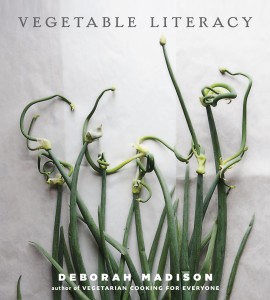 A reminder: Deborah Madison, chef and cookbook writer extraordinaire, will be at the Odyssey bookshop in South Hadley on Weds. Sept. 18 at 7 p.m. In her honor, we’re giving away a copy of her newest book, Vegetable Literacy. To be eligible to win, you must be a member of the Hampshire College community and enter a comment on any post in the Food, Farm and Sustainability blog by Tuesday, September 24 at noon. Please note that the deadline to enter has been extended by a week. It’s a gorgeous book and one deserving a prime place on any vegetable-eater’s bookshelf.
A reminder: Deborah Madison, chef and cookbook writer extraordinaire, will be at the Odyssey bookshop in South Hadley on Weds. Sept. 18 at 7 p.m. In her honor, we’re giving away a copy of her newest book, Vegetable Literacy. To be eligible to win, you must be a member of the Hampshire College community and enter a comment on any post in the Food, Farm and Sustainability blog by Tuesday, September 24 at noon. Please note that the deadline to enter has been extended by a week. It’s a gorgeous book and one deserving a prime place on any vegetable-eater’s bookshelf.
Jonathan Lash’s Gazpacho
6 large ripe tomatoes, peeled
2 cucumbers, peeled and chopped
1 green pepper, seeded and chopped
1 sweet onion, chopped
1/4 cup good olive oil
2-3 tbsp. vinegar (sherry vinegar or red wine vinegar)
6 slices of stale bread, cut or torn into chunks
fresh basil
fresh thyme
hot sauce, to taste
salt, to taste
sugar, to taste
Peel and dice the tomatoes and allow them to sit for 30 minutes with some salt and sugar. (The easiest way to peel tomatoes–and other hard-to-peel fruits, like peaches–is to drop them into a pot of boiling water for a minute or so. The skins will then slip right off.) Then place the tomatoes in a large non-metal bowl (ceramic or glass, ideally) with the chopped cucumber, pepper, onion, basil, and thyme. Add the olive oil, vinegar hot sauce, pepper and stale bread, then add enough water to cover the mixture. Stir, then refrigerate covered for at least 2 hours. Then run through food processor in small batches. If you don’t have a food processor, you can also use a regular blender or an immersion blender. Most should be liquified, but one batch can be left somewhat chunky, depending on taste. Chill again and serve in chilled bowls garnished with chopped parsley and basil.
************************
Tomato bonus: I recently ran across this poem by the wonderful Chilean poet and Nobel Laureate Pablo Neruda. It’s part of his series of odes to everyday things (onions, a tuna, firewood, laziness), his Elemental Odes. Since we are reaching the end of this year’s stunning tomato season, it seemed the appropriate time for this poem.
Ode To Tomatoes | by Pablo Neruda


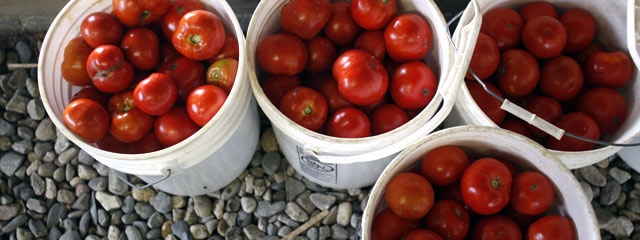
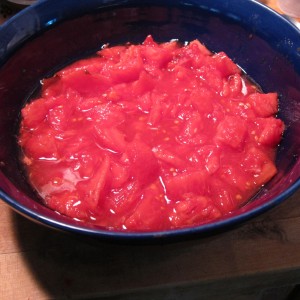
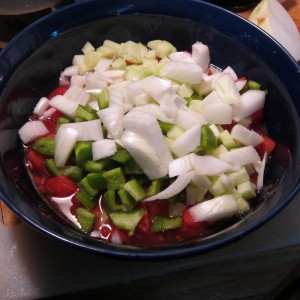
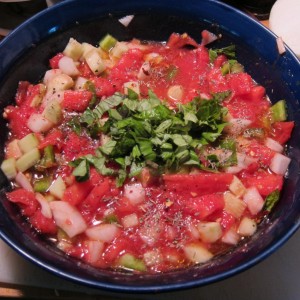
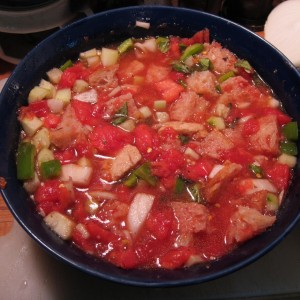
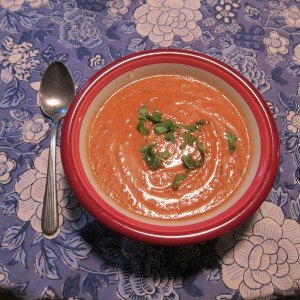
Yum! I made gazpacho last week, but I didn’t let it sit before blending it, or add bread. I’ll have to give this version a try. It sounds delicious!